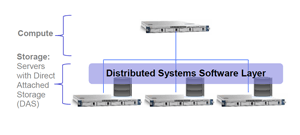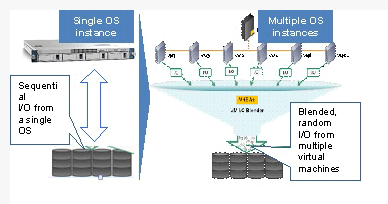infoTECH Feature
Is it 'Game Over' for the Current Set of Disruptions in the Storage Market?
Driven by a number of technology disruptions, 2013 was a banner year for venture backed storage company exits. This is no surprise given that enterprise storage systems comprise a $28 billion market. The trend towards converged infrastructure, particularly converging compute & storage into virtual storage area networks (vSAN), was evidenced by the VMware and EMC (News ![]() - Alert) acquisitions of Virsto Software and ScaleIO respectively. All the while, Nutanix and SimpliVity continued on their high growth trajectories. Moreover, details recently emerged about VMware’s own vSAN product. This segment has early traction in targeted use cases such as VDI and specific market segments including the SMB / SME markets. In this market, there is desire to deploy applications that have performance requirements that dictate the use of a SAN, but where there is no in-house expertise or appetite to deploy complex and expensive technology.
- Alert) acquisitions of Virsto Software and ScaleIO respectively. All the while, Nutanix and SimpliVity continued on their high growth trajectories. Moreover, details recently emerged about VMware’s own vSAN product. This segment has early traction in targeted use cases such as VDI and specific market segments including the SMB / SME markets. In this market, there is desire to deploy applications that have performance requirements that dictate the use of a SAN, but where there is no in-house expertise or appetite to deploy complex and expensive technology.
The availability of new types of media has already dramatically impacted the storage landscape. Enterprise demand for solid-state storage products has been driven by the growing application performance needs of databases, analytics and VDI. Not to mention the havoc that the server virtualization IO blender is wreaking on traditional hard-disk-based storage infrastructure. Flash can provide two orders of magnitude better IO performance, is cheaper on a $/IOP basis and requires less energy than traditional spinning hard-disks. In this sector, Western Digital acquired Virident, Cisco (News ![]() - Alert) acquired Whiptail and Violin Memory went public. Finally, the year ended with a bang as Nimble Storage went public to become the early leader in the pure-play hybrid storage market, filling the void left in the channel by Dell’s acquisition of Equalogic and HP’s acquisition of LeftHand Networks. The total of all these transactions was more than $3B at the time of the deals and more than $4B if you account for the appreciation in Nimble’s shares since the IPO.
- Alert) acquired Whiptail and Violin Memory went public. Finally, the year ended with a bang as Nimble Storage went public to become the early leader in the pure-play hybrid storage market, filling the void left in the channel by Dell’s acquisition of Equalogic and HP’s acquisition of LeftHand Networks. The total of all these transactions was more than $3B at the time of the deals and more than $4B if you account for the appreciation in Nimble’s shares since the IPO.
VMware / Virsto (~$200M)
EMC / ScaleIO (~$300M)
Western Digital / Virident ($685M)
Cisco / Whiptail ($415M)
Violin Memory IPO ($700M); Currently trading at $300M
Nimble Storage IPO ($1.2B); Currently trading at $2B
Given all the liquidity, it would be prudent to ask “if we’re past the 7th inning stretch in this wave of storage market dislocations?” Fortunately, we’re still in the early innings. While the flash and converged compute / storage space may have seen the large players place their bets and early leaders emerge, there are still significant market disruptions taking place that provide opportunity for entrepreneurs and investors. Below are the most interesting areas.
Scale-out storage based on commodity server hardware:

The most cost efficient data centers in the world are operated by the hyper-scale data center companies (Amazon, Google, Facebook, Twitter (News - Alert), Microsoft Azure, etc.). Given the scale at which they operate, these companies cannot afford to buy traditional storage systems. They have built distributed infrastructure on which to store their data using direct attached storage in commodity servers with intelligent software running on top. As storage demands continue to grow in a superlinear fashion, enterprises would like to adopt these hyper-scale data center storage paradigms but lack the expertise and resources in distributed systems to build their own solutions. The next generation of start-ups in this area is looking to provide software or integrated systems that help customers reduce storage costs by providing block or file storage on commodity hardware and enabling the purchase of storage in an incremental (scale-out) fashion. This allows them to start-small and grow incrementally without forklift upgrades. Many of these systems are being built with object storage as the underlying technology to achieve scalability required by true scale-out systems.
Cloud Storage & Object Storage: The growth of unstructured data continues unabated. At the same time, the consumerization of IT and new off-premise storage solutions for certain market segments, such as the small-medium-business market, have led to the increased use of cloud storage. Amazon now has more than a trillion objects stored in S3. Additionally, enterprises realize that some of their next generation applications will run on object storage. Of course they would like to have a single storage infrastructure that can serve today’s applications and the next generation of applications, so look for many object storage vendors to add file and block storage access as well. Look for these companies to compete with the companies in the previous segment over time. As noted above, the back-end of many of the next generation of disruptive storage start-ups is built on object storage due to its technology characteristics (scale-out, single namespace, geo-distribution, multi tenancy, data protection).

Virtualization is the gift that keeps on giving to the storage market. Initially, it drove the adoption of solid-state flash storage to meet the performance demands the IO blender created on the traditional storage subsystem. If the use of flash is the brawn for attacking the issues related to virtualized server performance, then VM-aware solutions are the brains. As server virtualization reaches the majority of enterprise workloads. A number of start-ups are pursuing intelligent and novel methods that create caches (read as new tiers of storage) with algorithms that are optimized for virtualized infrastructure. Some of these solutions also include storage services (snapshots, clones, replication) on a VM granularity basis.
Despite all the activity in 2013, we’re “early in the game” and there still exists a number of disruptions in storage that could alter the current ecosystem and are capable of supporting stand-alone companies. While the discussion above highlights the areas we like, they are by no means the only areas where innovation is taking place. Such innovation might also take the form of new storage services, which buyer is targeted, or means of distribution used to reach that buyer as a way to dislodge the incumbent vendors. If you’re working on a disruptive storage innovation or solving a difficult storage problem that provides value to customers, we’d love to meet with you.
About the Author: Matt focuses on investment opportunities in the IT infrastructure space. Specifically he’s interested in opportunities that capture the remaking of the application infrastructure delivery stack - from compute, storage and networking to databases, management and orchestration. Previously, Matt worked in Corporate Development at Cisco Systems (News ![]() - Alert) where he focused on strategy, acquisitions and investments in the data center segment. Prior to joining Cisco he was at a venture capital firm. His transaction experience includes Virident, Desktone, Whiptail, Jungo Software and Matrix Semiconductor. Early in his career, Matt was a ASIC design engineer and a product marketing manager at Terayon Communications Systems (News
- Alert) where he focused on strategy, acquisitions and investments in the data center segment. Prior to joining Cisco he was at a venture capital firm. His transaction experience includes Virident, Desktone, Whiptail, Jungo Software and Matrix Semiconductor. Early in his career, Matt was a ASIC design engineer and a product marketing manager at Terayon Communications Systems (News ![]() - Alert) where as an early employee he architected and designed some of the worlds first cable modem chips.
- Alert) where as an early employee he architected and designed some of the worlds first cable modem chips.
Edited by Maurice Nagle
infoTECH Headlines
What Is AWS EFS? Features, Use Cases, and Critical Best Practices
Cost-Effective Approaches to s1000d Conversion
A virtual crossroads for technology enthusiasts
Benefits of employee monitoring software in preventing overworking of workers
CI/CD: Trends and Predictions for 2024
Technical Documentation for IT: A Practical Guide
Managing Your Costs on AWS: A 2024 Guide
What Is Application Dependency Mapping?
Top 5 Kubernetes Errors and How to Solve Them
How Artificial Intelligence Can Improve the World of Online Gaming Platforms
Rich Tehrani
Rich Tehrani



 By
By 
